
9 tips for doing business with European buyers of grains, pulses and oilseeds
If you want to enter the European market for grains, pulses and oilseeds, you will be interacting with people with different cultures and product interests. It is very important to understand how people do business and how to meet their expectations and standards. Choose buyers that fit your company’s profile well. Show them reliability and consistency in your supply.
Contents of this page
- Make yourself an attractive supplier
- Create a unique proposition
- Evaluate your buyers
- Know your buyer before quoting your offer
- Send representative samples and laboratory tests
- Follow the latest market requirements
- Build long-lasting business relationships
- Development yourself as a supplier
- Find collaboration of support agencies
1. Make yourself an attractive supplier
Products in the grains, pulses and oilseeds industry are diverse and so are their different business ethics and cultures. Business cultures range from traditional for main commodities to more personal for special ingredients and products. To present themselves as attractive suppliers, companies in this industry often focus on quality assurance, traceability and transparent communication to build trust with their buyers.
Take away risks for your buyer
One of your main tasks is to take away the risks for your buyer. Adjust your approach according to the risk profile of your product. The risk is highest for food-grade grains, pulses and oilseeds for direct consumption and for products with specific characteristics such as organic or gluten-free. Taking away potential risks for your buyer starts with meeting the right standards and certifications. Most buyers will require you to have a GFSI-recognised food safety certificate. For bulk products that receive additional treatment or processing, a HACCP-based system is often enough.
It is also important to gain trust with your buyer through building steady business relations. This is best achieved via a personal approach and by being open and honest about your intentions. Honesty will get you more information and time from your business relation.
Figure 1: Risks and requirements for different types of products
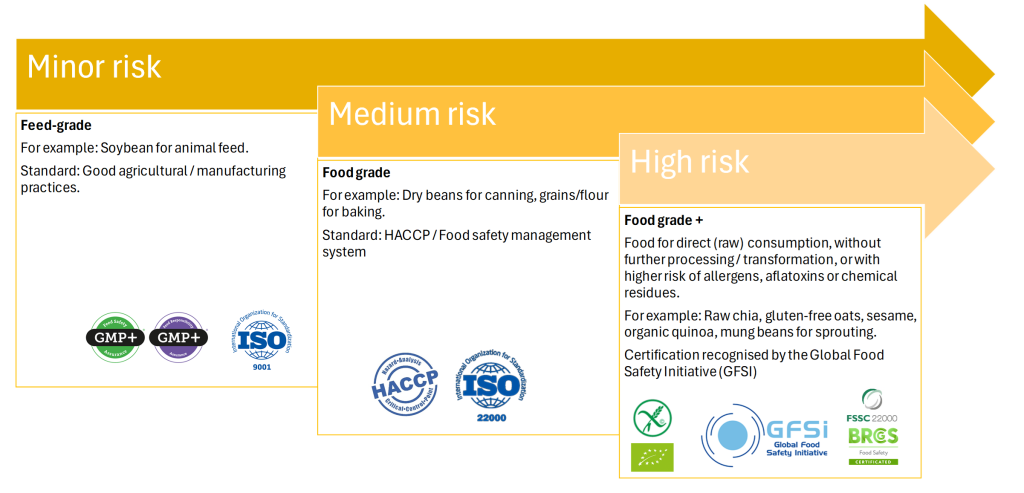
Source: ICI Business
Use a personal approach for niche products
Large commodity buyers will use formal procedures like purchase contracts and supplier declarations, sometimes without being interested in the person behind the product. For products that require extra attention in terms of traceability, food safety and quality, you can personalise your approach much more. Buyers will often want to see the production facilities for themselves and meet the person behind the product. Personal contact helps your buyer to mitigate risks, for example if the product involves many small farmers (such as quinoa, teff or fonio) or if it is difficult to source (such as organic chia or sesame seeds).
Adjust to different business cultures
A good communication style is necessary to avoid misunderstandings. General communication should always be clear and to the point. To confirm and record agreements, it is best to use email.
The preferred communication style and tools can be different for each European country, as well as for each individual buyer. Be flexible and adapt to the circumstances. Understand your buyer’s business culture and try to adapt to their way of doing business. This does not mean that you have to go along with their every wish, but follow their business etiquette.
For example, in Germany, the business culture can be formal and hierarchical, and you should focus on the facts and use rational arguments. Rationality is also an important part of Scandinavian business culture, although their style of doing business is much more informal and done through consensus. In the Netherlands, people will appreciate a direct communication style, while in the United Kingdom, indirect communication is considered most polite. In the Mediterranean countries, business partners value their relationships and spend more time in maintaining them.
Tips:
- Choose the countries that offer the best opportunities for your product. Use the CBI product studies for different types of grains, pulses and oilseeds. Also consider the countries that you are most familiar with. See where you have existing trade contacts or speak the local language.
- Keep your first contact moment short and to the point. The goal of your first contact moment is to create initial interest and make sure you get a follow-up. The first contact moment can be an introduction by email or a short phone call. Do not give up too easily. People have different ways of turning you down. This does not mean that they are not interested – it may be because they don’t have time or it is a low priority.
- Be on time for meetings. Meetings are often scheduled in advance and being on time is important. At trade fairs, meetings may be less organised; but at least establish contact in advance if you want to meet with a new company. Greet them with a firm handshake and make eye contact.
- Make sure you make contact with the company’s decision-maker, or at least someone who would be involved in purchasing your product (for instance, someone with the title Purchasing Manager, Buyer, Procurement Manager, Category Manager or Supply Chain Specialist). In some cases, your product must be approved by a higher manager or the company director.
- Learn about how to do business in Europe by reading about the different European business cultures and etiquettes in Passport to Trade 2.0.
2. Create a unique proposition
Your value as a trade partner is mainly determined through compliance and price. Price is a crucial point in every negotiation. But price should not be your only unique selling point (USP). If you trade bulk commodities, you will be part of a structured and efficient supply chain. Price is often pre-determined by international stock markets and the rest is paperwork. Niche products and food ingredients require more negotiation and quality control. This will give you more room to stand out as a supplier.
Figure 2: Visualisation of a unique selling point
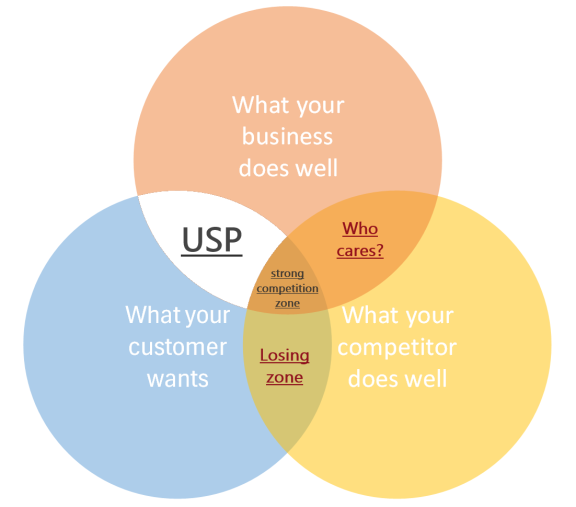
Source: ICI Business
Find your unique selling points
You need to work at the same level as your competition, but you should also search for areas in which you can outperform them. Make your strengths part of your export strategy.
Try to stand out and link your products to the needs of your potential buyers. With protocols and certification, you can overcome any objections from your buyer. Specific attention to quality and superior processing can set you apart from your competitor. With a high service level, you can rise above your buyer’s expectations. Think about providing favourable logistics or purchase conditions.
Highlight what makes your product special for the European market. Include aspects with a competitive advantage and focus on the right type of buyers. For example, attract specific buyer groups with a separate processing line for gluten-free grains. You could focus on the ethnic market if you are offering aromatic, specialty rice. Or target an exclusive food brand if you can produce a premium variety. You could also show your commitment to small farmers through targeting companies with fair-trade products.
A good example of a cooperative that has organised itself well is Coopake in Burkina Faso. With a strong focus on innovation and community development, this cooperative was able to impress the French fair-trade company Ethiquable. Via this French company, Coopake markets a variety of products in Europe, including sesame and sesame oil.
The Bolivian farmer association Anapqui stands out with its Royal Quinoa variety (Quinoa Real). The association is one of the main promoters and suppliers of this large-grain variety, which is farmed by small farmers in the highlands of Bolivia. With this superior product, they have a long-term cooperation with the German company Rapunzel and are partners in the their HAND IN HAND fair-trade programme. See other suggestions and examples of standing out (via unique selling points) given in Figure 3.
Figure 3: Examples of standing out (unique selling points)
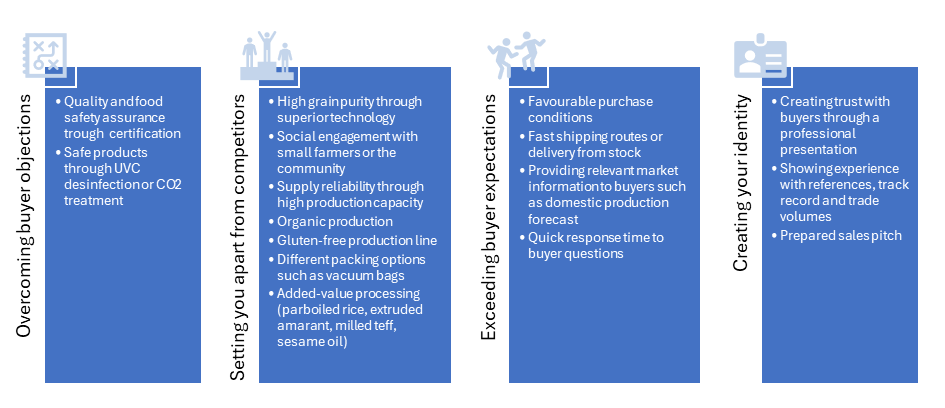
Source: ICI Business
Promote your story online
Doing business is about sharing information. Once you have defined your strength as a company, you need to tell your story to your buyer. You can do this through marketing.
A basic marketing tool is a website. Before your buyer does business with you, they will likely try to find information about your company first. It is important that you know what you would like to communicate online. Your website or online presence should answer the basic question of why a buyer should get into business with you. For example, you can show your production capacity, experience or certifications, like on the website of Andes Harvest in Figure 4. Support your story using visuals. You could also choose to make a video to show your production facilities and company values, like the company SHARES Uganda has done (Figure 5).
Figure 4: Example of company strengths and website presentation
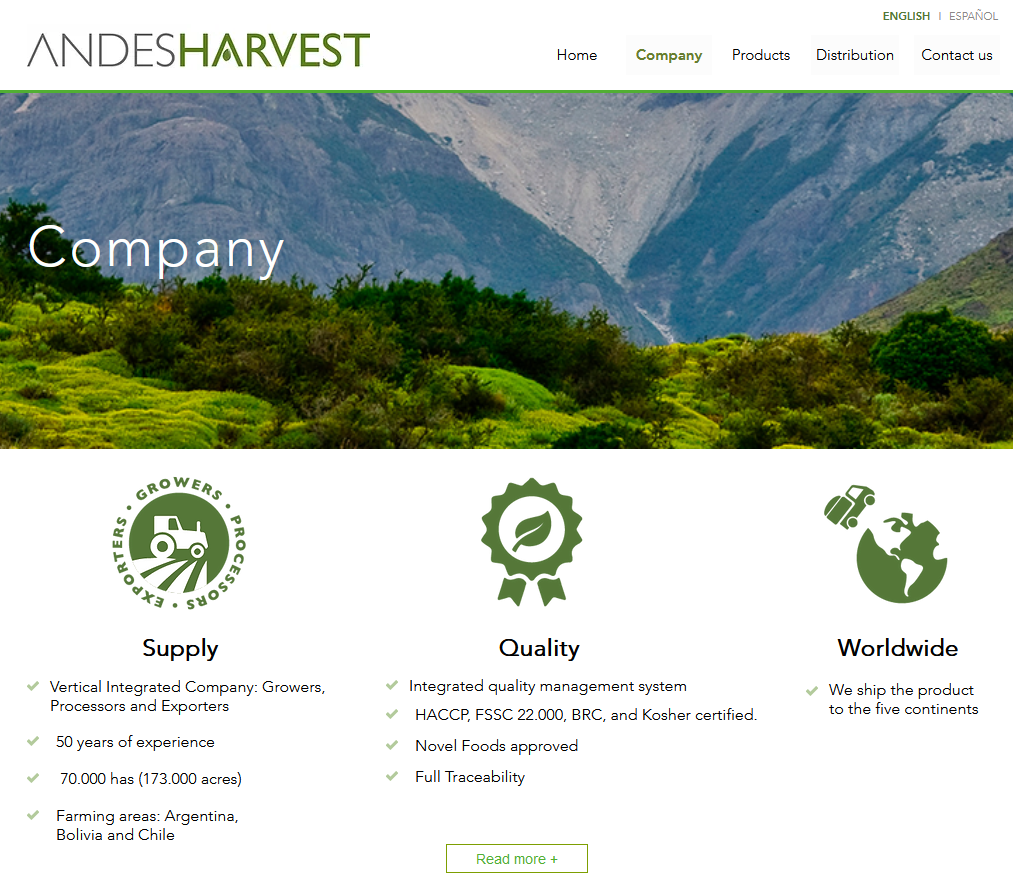
Source: Andes Harvest
Figure 5: Example of company video
Source: Shares Uganda
Listen and show experience
Your presentation skills are important when promoting your unique selling points (USPs). Instead of telling buyers you have the best quality grains or seeds, explain what makes you a reliable supplier and how you manage your business.
Tell your buyer about your organisation and your track record and show your production process. Show the buyer that you know your business well. This creates trust and gives your potential buyer a good impression of your seriousness. Certifications are important to add in your marketing, but your company values and how you apply them in practice are more personal and therefore add more character to your offer.
Find information about your potential buyer. Most buyers of grains, pulses and oilseeds have a website. Listen and understand their needs and requirements. Get to know your buyer before sending your presentation or quotation.
Tips:
- Show your social engagement. Promote your activities that benefit farmers, families and communities, like educational programmes or health services. Show these activities on your website or social media.
- Use professional visuals like images or videos to present your company. Visuals can be more effective than long texts.
- Read our tips for finding buyers for more ideas on how to present your business and ways to connect to buyers.
3. Evaluate your buyers
When you find a new buyer, evaluating them will help you avoid risks and spend your time wisely. Assessing the potential and relevance of a new buyer is especially useful if you have a lot of potential new buyers, such as at a trade fair.
How to evaluate your new buyers
To evaluate a potential new buyer, you can look at their company, their interests and their potential as a buyer. When your buyer database grows, you can prioritise your buyers by rating them, for example into A, B or C buyers.
Company – How serious are they as a buyer?
- Check the company details, like their website, physical address and business cards. If they use a Gmail or Hotmail email address, or if they are located in a residential flat, they are probably not your most important potential buyer.
- Check the company’s financial records or their creditworthiness through an export credit agency like Graydon Creditsafe or Dun & Bradstreet
- Check their track record: How many years have they been in business? Who are their clients?
Interests – Is it a good match?
- What type of products do they handle?
- What type of clients or markets do they work with?
- What are their values?
- Do their interests fit your business? For example: If you only supply organic grains, what percentage of organic does your potential buyer manage? If your potential buyer mainly serves the canning industry, are your pulses suitable for canning and do they maintain their colour and texture? Do your sesame seeds look good enough to be a bakery topping, or are they more suitable for oil pressing?
Potential – How important are they as a buyer?
- How big is the company?
- How much of your product would they like to buy, and how regularly?
- What are the purchase conditions?
- Are they focused on a quick sale or a long-term relationship? Your personal feeling about the potential buyer may also play a role.
Document your sales activities and communication
If you work with multiple clients, it is best to record your communications and sales with your buyers. You can make your client contacts digital by using Customer Relationship Management (CRM) software. The advantages of CRM software is that you can keep an overview and you can always refer to previous communication. You can also use a CRM to build more personal relations. Look online for different CRM options.
General purpose of using a CRM:
- To store your buyer data and communication history
- To record your agreements and contracts
- To plan follow-up actions
- To send newsletters
- To share sales activities with colleagues
Tip:
- Organise your buyer contact list and find a system that works for you. Some companies work with simple Excel sheets while others professionalise it with CRM software. Either way, it is important to record your buyer relations and have continuity in your follow up.
4. Know your buyer before quoting your offer
Well-known buyers regularly get quotes from potential suppliers with price information. Other buyers may ask you to email your quote after your first introduction. However, your buyer will not be looking for a price: they will be looking for a good and reliable deal. Whether this deal is with you depends on your relationship with the buyer and the level of trust you have gained.
Pricing
Do not make your price your only selling point. Realise that before becoming a supplier, you will often need to fill in forms and send copies of your certifications. Price quotes will only provide the buyer with market information and potential input to re-negotiate with their preferred supplier.
For higher volumes or long-term contracts, you can decide to offer more competitive prices and secure a longer relationship. If you are working with products such as wheat, maize or soy beans, the prices are largely determined by the international commodity exchange market. You can find these prices on Euronext, for example. In this case, it is more about the moment when you sell, rather than your negotiation skills, either through future contracts or on-the-spot marketing, for example.
Know your buyer
It is not always easy to know if a company is genuinely interested in your product. Know your buyer before sending them a quote. Try to get more details about their needs when you are asked for a quote. Find out what your buyer considers most relevant and emphasise this in your quote. The buyer is more likely to accept your quote if you have met them before, for example at a trade fair. Hard selling techniques, like sending quotes without being asked for them (‘unsolicited’), often do not work.
If you want to send a quote to new buyers, make sure your communication is effective. Research the company you are writing to and personalise your message. Figure 6 provides some tips on an actual acquisition email.
Figure 6: Example of an acquisition email and tips to improve it
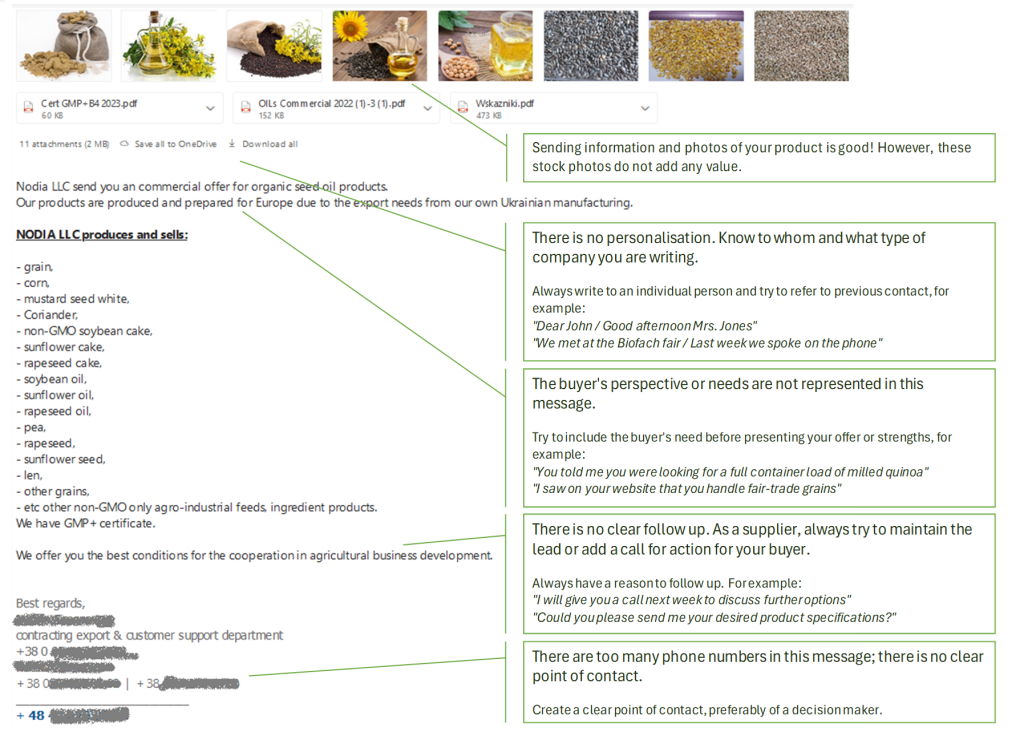
Source: ICI Business
Information to include in your quote
When you send your quote, stick to the point and be complete in your information. Table 1 shows an example of which information you can include in your quote. Include a technical data sheet to avoid any misunderstandings about the product specifications. See, as an example, the product information on organic amaranth seeds of DO IT Organic.
Make sure you know about your buyer’s purchase conditions. Ask for these or download them from their website; see, for example, the purchasing conditions of LDC for the EMEA region. As a supplier, you can also propose your own conditions and refer to these in your quote. Either way, always make sure that the trade conditions are clear. Do not take this lightly. If the buyer issues a claim, you will need this evidence. Always make sure you get your quote and conditions confirmed and signed before you ship the goods.
Table 1: Example of information to include in your quote
| PRODUCT SPECIFICATION | Organic sesame seeds, white, natural Premium quality (purity 99.7%) (add a technical product sheet) |
| PRICE & INCOTERM | $1,250 USD per tonne FOB |
| CERTIFICATIONS | EU Organic by ECOCERT (add a copy of the certification) |
PACKAGING | 25 kg polypropylene or multilayer paper bags Stacked with protective liners, no pallets |
| SHIPMENT(S) | 3 x 20” FCL (Full Container Load) / 19,700 kg 1 FCL per calendar month |
| DURATION OF CONTRACT | 3 months until 31-12-2024 |
| ORIGIN | India |
| SHELF LIFE | 12 months |
| TERMS OF DELIVERY (Incoterm) | FOB (CIF possible on request) |
| TERMS OF PAYMENT | 25% advance payment, 50% CAD (Cash against Documents), 25% within 21 days of delivery, T/T (Telegraphic Transfer) |
| PORT | Mumbai, first week of October (2024) |
| EXPIRY DATE OF OFFER | 25 August 2024 |
Tips:
- Find out what kind of company you are dealing with and what needs they have. A large part of your success depends on your skills and how you do your research beforehand. Help your potential buyer by taking away the risks of doing business with you. Make your offer stand out by highlighting your strengths or unique selling points.
- Try to secure a long-term commitment with buyers. Large food brands and importers that take part in supply tenders usually commit to supply contracts and negotiate multiple shipments. As a supplier, this gives you more security, but you must complete your side of the deal as well. This is easier if you manage your own production.
5. Send representative samples and laboratory tests
Samples are a good way to show the quality of your products and that your product meets the market standards. The more risks a product involves, the more thorough the sampling and analysis will be. For example, organic chia will be checked much more thoroughly than bulk corn for processing. And some products have a higher acceptance for residues than others. For example, the allowed residue level for glyphosate in lentils is 10 mg/kg, for maize 1 mg/kg and for sesame and quinoa 0.1 mg/kg. For certified organic grains, pulses and oilseeds, the residues must not be detectable.
If your buyer asks for a sample, make sure the sample is well packaged and representative of the lot you have reserved for the particular buyer. It is useless and even considered fraudulent to send samples that do not correspond to the quality of the rest of the lot.
A representative sample is generally taken from different parts of a lot by trained people. You can use an independent agency such as SGS or Bureau Veritas to take the sample to make sure it is done properly and according to standards (such as ISO 7002).
For sampling, you can take the following steps:
- Define the lot: Ask your buyer for their required product specifications and choose the lot that meets these standards. If necessary, analyse the sample first yourself.
- Sample it: Have a sample taken and register the sample to make sure you can trace it back to the right lot.
- Add data: Add a technical data sheet with a detailed product description and information about the analytical, nutritional and microbiological properties.
- Label it: Clearly state it is a sample with negligible value. You can avoid import taxes by adding a pro-forma invoice with zero value and stating it concerns a ‘sample for testing purposes’.
- Package it: Package and seal the sample properly. Clearly state it is a sealed sample so that customs do not open it.
- Confirm receipt: Confirm whether the buyer has received the sample and follow up on it.
If you (also) share a laboratory test to measure residue levels, make sure the test is done by an accredited laboratory. Be aware that testing methods and results can be different between laboratories and countries. So, it is best to have samples tested by the buyer as well, or by their preferred laboratory.
Tips:
- Read the FAO General Guidelines On Sampling to carry out sampling procedures and choose a sampling plan.
- Find the maximum limits for pesticide residue for different products in the EU Pesticide database.
6. Follow the latest market requirements
You must comply with European quality and safety standards when doing business with buyers from the EU. Make sure to keep your certifications up to date and regularly discuss new developments with your buyers. You must look ahead for new requirements rather than downgrading your current level.
Keep documentation and certifications up to date
To guarantee food safety, there are different levels of compliance. The minimum level is to follow HACCP principles and certify food or feed safety management. You should expect to upgrade your certification to a GFSI-recognised scheme, like FSSC22000, BRCGS or IFS, once you deal with food-grade or specialty grains, pulses and oilseeds.
For environmental and social aspects, individual company standards are often used. General standards such as GlobalG.A.P., amfori-BSCI, Sedex SMETA, Ethical Trade Initiative (ETI) and Rainforest Alliance may be used as well. Certifications such as organic, Fair Trade, non-GMO, gluten free, halal and kosher will open the door for you to access specific niche markets.
Buyers generally ask for a copy of your certifications, also when they have to be renewed. All certifications will require regular audits to keep them up to date.
Besides copies of certifications, buyers may ask you for additional information. Be ready to send documentation such as analysis reports or pesticide spray registers.
Keep up with EU legislation
Maintain close contact with your buyers to keep yourself up to date about changes in legislation and trade restrictions. Sometimes, there are changes in the allowed residue limits and the frequency of product checks at the border.
The European Union has a Rapid Alert System for Food and Feed (RASFF) to exchange information between member countries if there are risks to public health coming from the food chain. Regular issues with a certain origin location can lead to a temporary increase in border controls and therefore higher import costs for your buyer.
This is the case for black-eyed beans from Madagascar (10% controlled on pesticide residues), rice from Pakistan (5-10% checks on Aflatoxins, Ochratoxin A and pesticide residues), sesame from Nigeria and Sudan (50% controlled on salmonella), sesame from Uganda and India (20% controlled on salmonella and Indian sesame 50% controlled on pesticide residues).
Check the REGULATION (EU) 2019/1793 (last update 27 June 2023) on the temporary increase of official controls and emergency measures regulating the entry of certain goods from certain third countries into the European Union.
Conflict management/solving issues
Be aware that your buyer will hold you responsible for supplying the product. If you fail to meet the standards, or if there are quality issues, the costs will be taken from your company. Pesticide residues are often a reason for a buyer to reject a product, in particular for organic certified products.
If your buyer rejects your product or makes a quality claim for whatever reason, try to work out a solution together. When dealing with a claim, you have to consider protecting your relationship with your buyer as well as your own (financial) interests.
- Investigate: First find the source of the problem. This is why product traceability, counter-samples and documentation are important.
- Negotiate: When you have found the source of the problem, negotiate a solution with your buyer. Find out if there are alternative markets for your product or check if you or your buyer have insurance that will cover the costs.
- Mediate: Sometimes, it helps to have a neutral third party to help mediate between you and your buyer. These services are often provided by law firms or institutes like the International Chamber of Commerce (ICC) or the International Trade Council. The Grain and Feed Trade Association (GAFTA) can also provide you with a mediator.
- Arbitrate: If you cannot come to an acceptable solution together or through mediation, your next step could be to use arbitration (formal dispute resolution), for example through the International Chamber of Commerce (ICC). You can also find an arbitrator through the Grain and Feed Trade Association (GAFTA).
- Go to court: In serious cases, a dispute can also be resolved through court proceedings.
Tips:
- Keep your records up to date and send renewed certificates to your buyers before they are due.
- Show that you care about the environment by implementing good farming practices. For example, promote the programmes that you implement at your farms related to crop rotation, integrated pest management, waste management, reforestation and carbon footprint reduction. Also keep track of your chemical use in spray registers.
- Find out what types of certifications are most relevant for you and your target markets. Check the CBI study on buyer requirements for grains, pulses and oilseeds and the ITC Standards Map.
- Take any quality issue or claim from your buyer seriously and help investigate the source of the problem. Solve the problem together, even if it is not a mistake on your part.
7. Build long-lasting business relationships
Long-lasting relationships are crucial to stay in the market. To achieve strong relations, you will need good networking and communication skills. Show reliability and consistency in your supply.
Patience
Do not expect your buyer to order products already during the first meeting; this can take a couple of months. Instead, build trust over a longer period of time. Be patient, keep your promises and be honest. Showing reliability and consistency over time will help convince your buyer of your value as a supplier. Be aware that buyers can sometimes be opportunistic, in the sense that they will only buy your product if it is convenient for them.
Good communication
Once you have established your first buyer relations, make sure you maintain efficient communication. Communication is very important to maintain a good business relationship. Reply quickly and consistently to emails, phone calls or any other form of communication. Not getting back within one business day shows a lack of interest.
After-sales service
Maintain a good after-sales service. Cooperate and think together on how to solve issues or benefit together from market opportunities. Buyers also appreciate when you are pro-active in sharing relevant information. Inform your client proactively about any possible delay or problem, check if the product has arrived and if the quality is as expected.
Prove that you are reliable and respect agreements
Once you have started business with your buyer, you ideally want the business relation to continue. That means you have to respect your agreements and fulfil the deal you have made. You must not change the conditions or the agreed price once these are established, even if market prices increase. Your buyer expects you to supply the quality and price that you agreed on, just as much as you expect your buyer to fulfil their obligation to pay you as agreed.
Preferential treatment
At a later stage, you can choose to give preferential treatment, such as offering better payment terms. For example, you could provide credit and open account selling (goods are shipped and delivered before payment is due), or explore cooperation in new projects.
Tips:
- Invite your potential buyers and plan on-site visits to your farm and/or facilities. It is a good way to give your buyer a better impression of your company and its capacity. It also allows you to build a stronger business relation.
- Use several communication tools, like a direct mobile phone, personal email address, WhatsApp and Skype so you are easy to reach for your business relations.
8. Development yourself as a supplier
Doing business with international partners allows you to explore new opportunities. You can develop partnerships further and explore the option of adding value.
Joint venture
Some companies could be interested in developing a deeper relationship. If you have worked with a partner for a longer time, there could be interesting possibilities to grow together.
European buyers like to have control over their supply chain. This could be a reason for them to co-invest or integrate some of their business activities with your company. For example, Selet Hulling PLC is a Dutch-Ethiopian joint venture initiated by Tradin Organic to produce and clean sesame seeds. Nature Bio Foods, an Indian origin company, also actively invests in sourcing countries such as Uganda, Togo and Benin. By cooperating with local farmers and processors, they help trade organic soy beans, sesame and chia from remote regions.
Diversify or add value to products
See if you can add more value to your offer. Diversify your product range or apply basic processing to your products. While most grains and pulses are traded as bulk products, basic processing into grain flakes, flour or oil (for example, quinoa flakes, lentil flour or sesame oil) can give you a competitive advantage with an exclusive number of buyers. Always follow the market demand if you want to add value – the market demand should lead your decision.
Tips:
- Learn about the potential of exporting speciality grains with added value to Europe and see what kind of products are being traded on the CBI market information platform.
- Decide the level of integration you want to have with your supply chain. With trusted partners, you can work on a consignment basis or choose to organise your own warehousing in Europe. Let your marketing budget and financial power be decisive factors for supply chain integration.
9. Find collaboration of support agencies
As a supplier, you can take advantage of organisations that support export growth, directly or indirectly. There are support organisations for trade development, as well as for advocacy and trade policy.
Trade development organisations
Being part of an export support programme gives you access to trade assistance, trade fair promotion, export training and sometimes funding for certifications. These activities will increase your chances with potential buyers. The examples below are European organisations that support exporters in developing countries, but you can also check if there are support organisations in your own country.
Centre for the Promotion of Imports from developing countries (CBI) provides small and medium-sized enterprises with market intelligence and trade support in export coaching programmes. The tailored programmes also include training on doing business in Europe. You can find relevant projects on the website.
Import Promotion Desk (IPD) establishes contacts in the European Union for exporters from partner countries and provides them with market information and capacity building. One of the sectors they operate in is natural ingredients, which includes grains and seeds (quinoa, amaranth, rice) and pulses (kidney beans, pinto beans, white beans, peas).
International Trade Centre (ITC) is a development agency for sustainable trade with publications and an SME Trade Academy that provides online courses (some are free of charge). Courses such as ‘Export Sales and Negotiation’ and ‘Helping SMEs Generate Export Business’ may be relevant if you want to develop yourself as an exporter of grains, pulses or oilseeds.
Open Trade Gate Sweden (OTGS) is a facility and one-stop information centre for exporters interested in the Swedish market. They aim to strengthen the capacity and ability of developing countries to export to Sweden, but their work can also benefit you for doing business with other European markets.
Swisscontact is an independent non-profit development organisation offering customised consultancy and capacity development services. They focus on sustainable economic development of the private sector in developing and emerging countries.
Trade policy
Organisations that help take away trade barriers can make a big difference in facilitating trade.
The Institute for Agriculture and Trade Policy (IATP) has a mission to ensure fair and sustainable food, farm and trade systems. By pushing for policy reforms internationally, IATP advocates for a fair and green transition that supports agroecology and promotes the fair exchange of goods and services.
TradeMark Africa (TMA) is an Aid-for-Trade organisation with the aim of growing prosperity through increased trade. They help take away trade barriers and increase sustainable and inclusive trade within Africa and exports to the rest of the world.
Tips:
- Check the current and upcoming projects by the CBI. See if any of these might be interesting for your company.
- Contact IPD if you think their services match your needs in increasing your knowledge about doing business in Europe.
- Subscribe for free or paid online courses with the ITC SME Trade Academy.
- Find Business Support Offices (BSOs) in your country and see what they can do for you. Many export or government agencies also offer space in country pavilions at major trade fairs in Europe.
Read our Tips for Finding Buyers and Tips for Organising your Export. These can help you further understand how to enter the European market and what it takes to become a successful exporter to Europe.
ICI Business carried out this study on behalf of CBI.
Please review our market information disclaimer.
Search
Enter search terms to find market research
